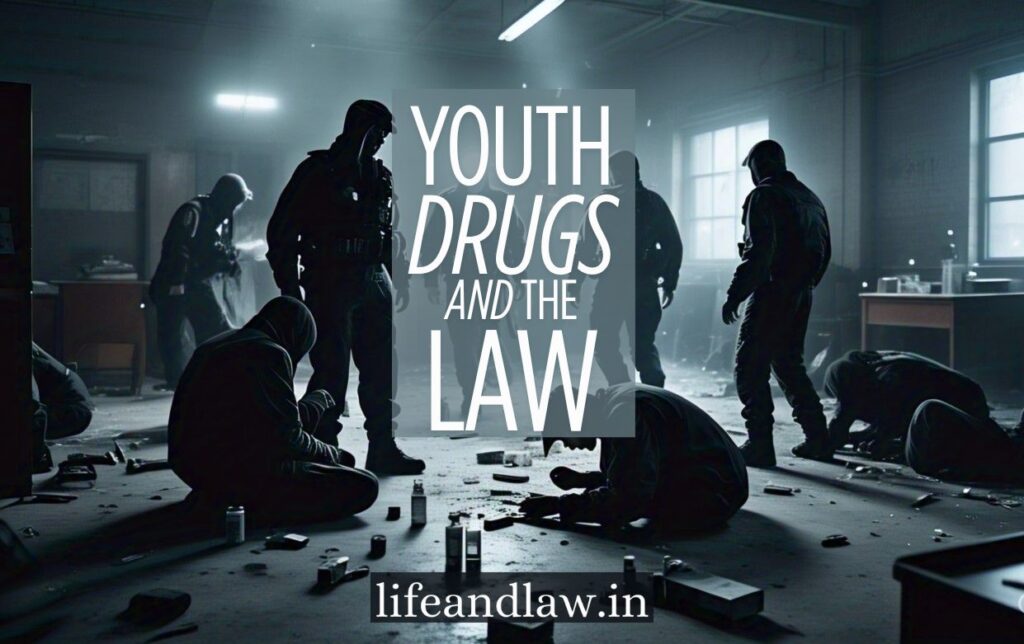Trending

India’s youth are increasingly abusing substances, which is causing alarm. Peer pressure, stress, and a lack of awareness are all significant contributors to increased drug use among teenagers and young people. However, the country’s legislative approach, particularly under the Narcotic Drugs and Psychotropic Substances (NDPS) Act, emphasizes punishment above prevention or rehabilitation.
This article investigates whether India’s current legal safeguards are genuinely effective in combating youth drug consumption, or if they are failing the same generation they claim to protect. By evaluating the country’s legal framework, implementation gaps, and worldwide comparisons, we hope to illustrate the critical need for a more youth-sensitive, reformist approach.
The NDPS Act, 1985, India’s primary legal tool against drug usage, provides harsh penalties—even for little amounts of narcotics—and frequently prioritizes punishment over rehabilitation. For example, possession of even little amounts of LSD, such as 1 gram, might result in jail.
While the Juvenile Justice Act of 2015 establishes a separate framework for minors, its unequal enforcement means that many young offenders end up navigating the adult criminal system without adequate help. Meanwhile, enforcement agencies such as the Narcotics Control Bureau (NCB) wield broad authority, but chronic neglect of mental health and de-addiction treatments undermines efforts to protect vulnerable children.
The data reveals a troubling picture. According to the National Crime Records Burea (NCRB) (2023), there has been a 22% increase in drug-related arrests of people aged 14 to 25 in the last 5 years. The United Nations Office on Drugs and Crime (UNODC) has also identified India as a growing hotspot for drug usage and trafficking routes.
But why are young Indians particularly vulnerable? Peer pressure, mental health difficulties, academic stress, and simple internet access to narcotics are all contributing factors. Ironically, instead of viewing these youth as victims in need of care, India’s present legal reaction frequently regards them as criminals to be punished.
A significant weakness in the NDPS Act is its failure to distinguish between first-time users and hardened offenders, which results in punitive bail terms and a reversal of the presumption of innocence under Section 35. This punitive approach frequently undermines rehabilitation and prolongs incarceration.
Furthermore, the lack of de-addiction centers and the arbitrary use of police power disproportionately harm vulnerable youth. With inadequate access to legal information and mental health help in schools, many young people end up with criminal records that jeopardize their future educational and job opportunities.
Compare this to Portugal, which decriminalized personal drug use in 2001. Instead of arresting juvenile drug users, authorities refer them to ‘Dissuasion Commissions’, which prioritize treatment over punishment.
The United States has also experimented with juvenile drug courts, which combine legal supervision with therapy, education, and community support, with the goal of reintegration rather than isolation.
India can learn a valuable lesson here: address addiction as a public health concern rather than a criminal one.
Indian courts have, on occasion, exhibited sensitivity. In Tofan Singh v. State of Tamil Nadu (2020), the Supreme Court ruled that officers authorized under Section 53 of the NDPS Act were ‘police officers’ and that statements made to them under Section 67 were inadmissible as evidence.
Government programs, such as the Nasha Mukt Bharat Abhiyaan, are positive moves forward. However, their success depends on combining legal reforms, institutional support, and societal acceptance.
Legal reform is urgent. The NDPS Act requires revisions that:
On the policy front, India must:
India is currently at a critical crossroads. We may either continue with a punitive strategy that risks stifling a whole generation’s potential, or we can choose to reform our drug laws with a focus on justice, rehabilitation, and youth empowerment. As we commemorate this International Day Against Drug Abuse and Illicit Trafficking, it is critical to remember that flawed legal frameworks can cost us our future—which we cannot afford to lose.
This essay was published by Adv. Abdul Mulla, a practitioner dedicated to increasing legal understanding in everyday life. For expert legal insights and support, visit www.lifeandlaw.in or www.asmlegalservices.in
Adv. Abdul Mulla (Mob. No. 937 007 2022) is a seasoned legal professional with over 18 years of experience in advocacy, specializing in diverse areas of law, including Real Estate and Property Law, Matrimonial and Divorce Matters, Litigation and Dispute Resolution, and Will and Succession Planning. read more….
Copyright BlazeThemes. 2025